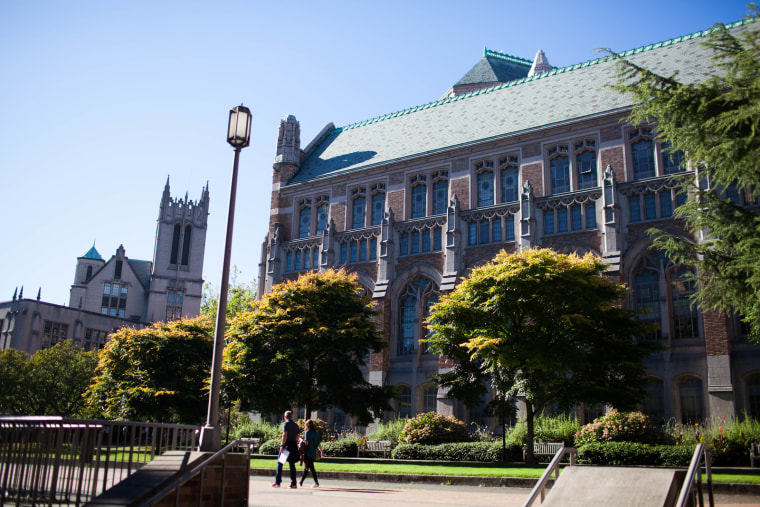Clara Cox was always good test-taker, and when she applied to college, she scored high on the SAT.
"I grew up in the New York state system, so I’ve done standardized testing since the time I could walk," said Cox, 26, who graduated from the University of Vermont with a degree in linguistics and French.
"But I do understand that some people don't test well,” she told NBC News. "And there is a huge fear of the SAT."
Some of her friends, including her own twin sisters, struggled with poor standardized test results; it would limit their college choices.

"We took the same classes and had the same grades," said Cox. "But I’ve seen students with low test scores and high GPAs — and those with SAT scores that were incredible that did not do so well."
Today, she is an admissions counselor at The University of New England in Maine, which still requires either the SAT or ACT, but a growing number of institutions do not.
Nearly 1,000 accredited four-year colleges and universities have test-optional or test-flexible admission policies, according to The National Center for Fair and Open Testing or FairTest.
The Massachusetts-based nonprofit promotes educational evaluations that strive to eliminate "misuse and flaws" of standardized testing at all grade levels. They say that these tests have inherent cultural and racial biases.
"We’re not opposed to the use of testing, only the misuse of testing," said Robert A. Schaeffer, public education director for FairTest. "We are 'fair test' not 'no test.' Tests can have a role."
Leveling the academic playing field
The first standardized test was launched in 1920 by the United States Army and was used to measure IQ. In 1926, a Princeton psychologist adapted the so-called Army Alpha test to use in college admissions.
A decade later, when Harvard University began a nationwide scholarship program to find talented students outside the usual East Coast boarding school pool, it turned to what had evolved into the Scholastic Achievement Test or SAT. In 1946, with the founding of the College Board, it became the universal testing tool.
Bowdoin College in Maine was the first to eliminate SAT and ACT testing requirements in 1969. A 20-year Bates College study of admitted students revealed that those who submitted tests did not show any better academic performance or graduation rates than those who didn’t.
The SAT was meant to help level the academic playing field, but FairTest’s Schaeffer says that was before admissions officers had detailed information about the rigor of particular high schools to compare students.
“That was back…before multiple studies proved that high school grades were a better predictor of undergraduate success than any test, before research showed a very strong correlation between test results and family income, and before the explosion of high-priced test-prep courses gave well-to-do families an opportunity to purchase the equivalent of steroids to improve their teenagers' scores,” Schaeffer told NBC News.
Grades are a better predictor of success in college, he said.
But Philip Ballinger, assistant vice president for enrollment at the University of Washington, says the SAT is still a vital tool in the admissions process. Ballinger has held multiple positions with the College Board — the organization that administers the SAT — during his career.
Washington still requires either the SAT or ACT as part of a "holistic review" of an applicant.
Test-optional schools argue the policy helps promote diversity, but Ballinger said, "My fear is a lot of schools go test-score optional for competitive reasons and rankings."

Bates, for example, said its testing policy saw an increase in students of color and international students. But, its study showed white students were taking advantage of the policy 5 to 1.
As a public university, Washington offers admission to students from a wide range of backgrounds; 38 percent are first-generation college students and about one-third are from low-income families.
"That test score helps me understand what we are obligated to offer in support for them to be successful," said Ballinger. "If I just went on their GPA, I would be doing a disservice to the student."
He advises high school students to take the SAT or ACT, even if they plan to apply to a school that does not require it. The tests give the student an opportunity to see their weaknesses and do more preparation.The free online education service Kahn Academy is one way to not only improve scores, but to "learn," said Ballinger. Meanwhile, Clara Cox agrees, “even if students think they might do poorly or intend to apply to a test-optional school.”
In the end, her sisters did some prep, retook the SAT and did well. One was accepted to competitive Mount Holyoke College and the other attended University of New England. Both were stellar students.
"The SAT doesn’t make you," said Cox, who now reviews applications and test scores. "There are so many other moving parts to your story. You are not just a test. You are a lot more — the essay, your high school grades, your GPA and your activities."
